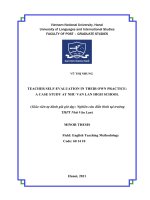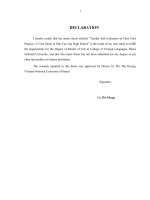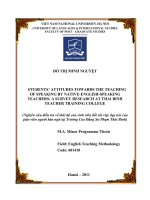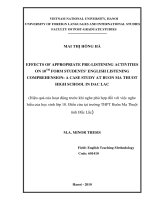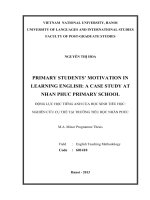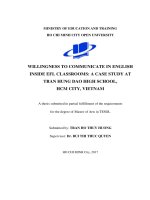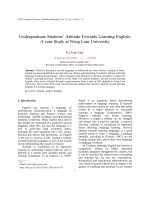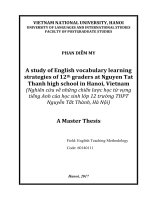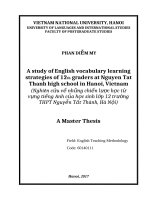efl students’ attitudes towards autonomy in vocabulary learning and their vocabulary learning strategies a case study at nguyen huu cau high school
Bạn đang xem bản rút gọn của tài liệu. Xem và tải ngay bản đầy đủ của tài liệu tại đây (1.19 MB, 128 trang )
MINISTRY OF EDUCATION AND TRAINING
HO CHI MINH CITY OPEN UNIVERSITY
LUC TIEU HOANG LINH
EFL STUDENTS’ ATTITUDES TOWARDS AUTONOMY
IN VOCABULARY LEARNING AND THEIR VOCABULARY
LEARNING STRATEGIES: A CASE STUDY AT NGUYEN HUU CAU
HIGH SCHOOL
MASTER OF ARTS IN TESOL
Ho Chi Minh City, 2019
MINISTRY OF EDUCATION AND TRAINING
HO CHI MINH CITY OPEN UNIVERSITY
LUC TIEU HOANG LINH
EFL STUDENTS’ ATTITUDES TOWARDS AUTONOMY
IN VOCABULARY LEARNING AND THEIR VOCABULARY
LEARNING STRATEGIES: A CASE STUDY AT NGUYEN HUU CAU
HIGH SCHOOL
Major: Teaching English to speakers of other language
Major code: 60140111
MASTER OF ARTS IN TESOL
Supervisor: TRAN QUOC THAO, PhD
Ho Chi Minh City, 2019
STATEMENT OF AUTHORSHIP
I certify my authorship of the thesis submitted entitled, “EFL students’
attitudes towards autonomy in vocabulary learning and their vocabulary
learning strategies: a case study at Nguyen Huu Cau High School” as the
statement of requirements for thesis in Master’s Programs at Ho Chi Minh Open
University, issued by the Higher Degree Committee.
This thesis does not contain material published elsewhere or extracted in
whole or in part from a thesis by which I have qualified for or been awarded another
degree of diploma, except where reference is made in the text of the thesis.
No other person’s work has been used without due acknowledgement in the
main text of this thesis.
The thesis has not been submitted for any degree in any other tertiary
institution.
Ho Chi Minh, July 2019
LUC TIEU HOANG LINH
i
RETENTION AND USE OF THE THESIS
I hereby state that I, Luc Tieu Hoang Linh, being a candidate for the degree
of Master of Arts (TESOL), accept the requirements of the University relating to the
retention and use of Master’s Theses deposited in the Library.
In terms of these conditions, I agree that the original of my Master’s Thesis
deposited in the Library should be accessible for the purposes of study and research,
in accordance with the normal conditions established by the Librarian for the care,
loan, and reproduction for theses.
Ho Chi Minh City, July 2019
ii
ACKNOWLEDGEMENTS
I would like to express my deep gratitude to those who have greatly helped
and encouraged me to complete my research. Without their support, my research
would be far from being completed. Hence, I am deeply indebted to the individuals
that provided support for the completion of this study.
First and foremost, my sincere and special appreciation goes to my
supervisor, Dr. Tran Quoc Thao, with my greatest gratitude for his valuable
guidance, advice and encouragement. He has supervised my entire thesis, and, most
importantly, given me a lot of helpful comments to get over the most problematic
period when I was stuck in finding solutions for my thesis. Undoubtedly, without
his enthusiastic support, it would be very difficult for me to complete this study.
Next, I would like to send my deep thank to all the lectures of TESOL
course, who oriented and inspired me to put the first step on the path of scientific
research.
Furthermore, I would like to thank to the Head of Nguyen Huu Cau High
School and the Head of English subject for facilitating best conditions for my
research. Particularly, I would also like to acknowledge all colleagues and 200
grade twelfth students at Nguyen Huu Cau High School for their contribution to the
completion of data collection. Without their willingness and generous help, my
research could not have been accomplished.
Last but not least, I would like to express my thankfulness to my adorable
brothers, sisters and friends for the love and encouragement gave me during my
study time. Especially, I am deeply grateful to my honorable parents for dedication,
support and sharing of feelings to help me overcome all the difficulties and to
become a better me now.
iii
ABSTRACT
Learner autonomy has been considered as a determining factor of success in
their own study. However, there are a limited number of papers on this issue in the
context of Vietnamese High School. The present study aimed at (1) investigating
EFL high school students’ attitudes towards autonomy in English vocabulary
learning, (2) identifying the strategies used by a group of 200 twelfth-grade students
studying at Nguyen Huu Cau High School in enriching English vocabulary
knowledge autonomously and (3) examining whether there is a difference in
vocabulary learning strategies use in terms of gender. The researcher employed a
mixed-methods design, involving both quantitative and qualitative approaches with
two research instruments: a questionnaire and a semi-structured interview. The
findings revealed that EFL high school students expressed positive attitudes towards
autonomy in English vocabulary learning. The results also demonstrated that EFL
high school students employed English vocabulary learning strategies at an average
frequency level when they encountered with vocabulary items. This current
investigation revealed six English vocabulary learning strategies used with high
frequency by the students. In other words, Nguyen Huu Cau High School 12th
students often utilized six following English vocabulary learning strategies, namely,
“Use a bilingual dictionary to find out the meaning of the word”, “Study words
through English songs”, “Ask teachers for L1 translation”, “Ask classmates for
meaning”, “Highlight new words” and “Say new word aloud when studying” in
order to enrich their knowledge of English vocabulary autonomously. Furthermore,
female students reported using vocabulary learning strategies more frequently than
their male counterparts. Based on these findings, some recommendations were
made for EFL students, EFL teachers and school administrators.
Keywords: autonomy; attitudes; case study; EFL students; vocabulary learning
strategies
iv
TABLE OF CONTENTS
STATEMENT OF AUTHORSHIP ......................................................................... i
RETENTION AND USE OF THE THESIS .......................................................... ii
ACKNOWLEDGEMENTS.................................................................................... iii
ABSTRACT ............................................................................................................. iv
TABLE OF CONTENTS ........................................................................................ v
LIST OF ABBREVIATIONS ................................................................................ ix
LIST OF TABLES ................................................................................................... x
CHAPTER 1: INTRODUCTION ........................................................................... 1
1.1 Background to the Study .................................................................................. 1
1.2 Statement of the Problem ................................................................................. 3
1.3 Purposes of the Study ....................................................................................... 6
1.4 Research Questions .......................................................................................... 7
1.5 Significance of the Study ................................................................................. 7
1.6 Definitions of Key Terms ................................................................................. 7
1.7 Overview of Thesis Chapters ........................................................................... 8
CHAPTER 2: LITERATURE REVIEW............................................................... 9
2.1 Introduction ...................................................................................................... 9
2.2 Learner Autonomy ........................................................................................... 9
2.2.1 Definition of Learner Autonomy ............................................................... 9
2.2.2 The Importance of Learner Autonomy in Language Learning ................ 10
2.3 Learner Attitude and Their Role in Language Learning ................................ 11
2.3.1 Definition and Domains of Learner Attitude ........................................... 11
2.3.2 The Importance of Attitude in Language Learning ................................. 13
2.4 Vocabulary and Its Importance in Language Learning .................................. 14
2.4.1 Definition of Vocabulary ......................................................................... 14
2.4.2 The Importance of Vocabulary in Language Learning ........................... 14
2.5 Vocabulary Learning Approaches .................................................................. 14
v
2.6 Vocabulary Learning Strategies ..................................................................... 15
2.6.1 Definition of Vocabulary Learning Strategies......................................... 15
2.6.2 The Importance of Vocabulary Learning Strategies ................................ 15
2.6.3 The Classification of Vocabulary Learning Strategies ............................ 16
2.7 The Difference of Learner Autonomy and Vocabulary Learning by Gender 20
2.8 Previous Studies ............................................................................................. 21
2.9 Research Gaps ................................................................................................ 25
2.10 Conceptual Framework ................................................................................ 26
2.11 Chapter Summary ......................................................................................... 29
CHAPTER 3: RESEARCH METHODOLOGY ................................................ 30
3.1 Introduction .................................................................................................... 30
3.2 Research Setting ............................................................................................. 30
3.2.1 Research Location ................................................................................... 30
3.2.2 Research Participants ............................................................................... 32
3.3 Research Design ............................................................................................. 36
3.3.1 Case study ................................................................................................ 36
3.3.2 Research Method ..................................................................................... 36
3.4 Research Instruments ..................................................................................... 38
3.4.1 Questionnaire ........................................................................................... 38
3.4.2 Interview .................................................................................................. 41
3.6 Data Analysis Procedure ................................................................................ 44
3.6.1 Procedure of Analyzing Questionnaire.................................................... 44
3.6.2 Procedure of analyzing Semi-structured Interview ................................. 46
3.7 Reliability and Validity .................................................................................. 47
3.7.1 Questionnaire ........................................................................................... 47
3.7.2 Semi-Structured Interview ....................................................................... 48
3.8 Chapter Summary ........................................................................................... 48
CHAPTER 4: RESULTS AND DISCUSSION ................................................... 50
4.1 Introduction .................................................................................................... 50
vi
4.2 Results ............................................................................................................ 50
4.2.1 EFL High School Students’ Attitudes towards Autonomy in English
Vocabulary Learning ........................................................................................ 50
4.2.2 EFL High School Students’ Use of Autonomous English Vocabulary
Language Learning Strategies .......................................................................... 54
4.2.3 Differences in Vocabulary Learning Strategies Use in terms of Gender 65
4.3 Discussion ...................................................................................................... 66
4.3.1 EFL High School Students’ Attitudes towards Autonomy in English
Vocabulary Learning ........................................................................................ 67
4.3.2 EFL High School students’ Use of Autonomous English Vocabulary
Language Learning Strategies .......................................................................... 69
4.3.3 Differences in Vocabulary Learning Strategies Use in terms of Gender 73
4.4 Chapter summary ........................................................................................... 74
CHAPTER 5: CONCLUSIONS AND RECOMMENDATIONS ...................... 75
5.1 Introduction .................................................................................................... 75
5.2 Conclusions .................................................................................................... 75
5.3 Implications .................................................................................................... 76
5.3.1 For EFL Teachers .................................................................................... 76
5.3.2 For School Administrators....................................................................... 78
5.3.3 For EFL Students ..................................................................................... 78
5.4 Limitations of the Study ................................................................................. 79
5.5 Recommendations of Further Research ......................................................... 79
REFERENCES ....................................................................................................... 81
APPENDICES ........................................................................................................ 89
APPENDIX A: QUESTIONNAIRE (English Version) ...................................... 90
APPENDIX B: QUESTIONNAIRE (Vietnamese Version) ................................ 94
APPENDIX C: INTERVIEW PROTOCOL (English Version) .......................... 99
APPENDIX D: INTERVIEW PROTOCOL (Vietnamese Version) .................. 102
vii
APPENDIX E: A SAMPLE OF THE INTERVIEW TRANSCRIPT WITH
STUDENT 2 (English Version) ......................................................................... 106
APPENDIX F: A SAMPLE OF THE INTERVIEW TRANSCRIPT WITH
STUDENT 2 (Vietnamese Version) .................................................................. 111
viii
LIST OF ABBREVIATIONS
COG:
Cognitive
DET:
Determination
EFL:
English as a Foreign Language
ESL:
English as a Second Language
L1:
First Language
L2:
Second Language
MEM:
Memory
MET:
Metacognitive
SOC:
Social
VLS:
Vocabulary Learning Strategy
ix
LIST OF TABLES
Table 2.1: Schmitt’s (1997) VLS classification ....................................................... 16
Table 2.2: Intaraprasert’s (2005) VLS classification ............................................... 19
Table 3.1 Research Participants’ General Information ............................................ 35
Table 3.2: Reliability Coefficient of the Questionnaire ........................................... 40
Table 3.3: Methods of Data Analysis in Relation to the Research Questions and
Instruments ............................................................................................................... 46
Table 4.1: EFL High School Students’ Attitudes towards Autonomy in English
Vocabulary Learning................................................................................................ 51
Table 4.2: Significance of Self-Learning English Vocabulary ................................ 52
Table 4.3: Interest of Self-learning English vocabulary .......................................... 53
Table 4.4 Frequency of students’ use of vocabulary learning strategies ................. 55
Table 4.5: Students’ use of DET vocabulary learning strategies ............................. 56
Table 4.6: Students’ use of SOC vocabulary learning strategies ............................. 57
Table 4.7: Students’ use of MEM vocabulary learning strategies ........................... 59
Table 4.8: Students’ use of COG vocabulary learning strategies ............................ 60
Table 4.9: Students’ use of MET vocabulary learning strategies ............................ 61
Table 4.10: Frequency Category of students’ vocabulary learning strategy use ..... 63
Table 4.11: Independent samples T-test: Differences in vocabulary learning
strategies use in terms of gender .............................................................................. 66
x
LIST OF FIGURES
Figure 2.1 A model of attitude formation(Luu, 2011) ............................................. 12
Figure 2.2 Schmitt’s (1997) Taxonomy of Vocabulary Learning Strategies ........... 18
Figure 2.3 Conceptual Framework of the Study ...................................................... 28
Figure 3.1: Research Design for the Present Study ................................................. 38
Figure 3.2: Research Methodology of the Present Study......................................... 49
xi
CHAPTER 1: INTRODUCTION
This chapter presents the background to the study, followed by the statement
of the problem. It then emphasizes the purposes and research questions of the study.
Moreover, the significance of the study is taken into consideration as well. Finally,
definitions of key terms and overview of thesis chapters are presented.
1.1 Background to the Study
Nowadays, with the rapid development of technology, it is undeniable that
language plays a very crucial role in human life in the world because it is
considered as a means of communication. In other words, language is used not only
to communicate but also to transfer information. According to Hornby (1995),
language is “the system of sounds and words used by human to express their
thoughts and feelings” (p. 662). Actually, more and more people from different
countries are communicating and exchanging ideas with each other by one
international language, namely the English language. To put it another way, English
can be regarded as a bridge used to connect people all over the world. Therefore,
teaching and learning English is of significance to educational demands. There is no
doubt that to master the English language, learners need to have necessary
knowledge of vocabulary apart from mastering the grammar rules. Truly,
vocabulary is one of the most important components of language learning in which
learners are able to use it in order to support for four language skills (Nation, 2001;
Richard & Renandya, 2002; Schmitt, 2010). Hence, the richer vocabulary
knowledge students have, the better they can master the language. Obviously,
vocabulary plays a vital role in any stages of the learners’ language development
(Balci & Çakir, 2011). Particularly speaking, vocabulary is one of the essential
aspects of the language learning process (McCrostie, 2007). Moreover, it is
impossible for a learner to communicate without the required vocabulary. Indeed, a
number of leading scholars (e.g., Wilkins, 1972; Willis, 1990; Lewis, 1993; Folse,
2004) in the field of vocabulary believe that communication can occur without
1
syntax and grammar, but not vocabulary. This above-mentioned statement draws
the importance of vocabulary in any languages in general and in English in
particular. No one can deny that if learners have no vocabulary, they cannot express
their ideas, thinking or feelings as well as are unable to understand the meaning of
written and spoken texts. Thus, it can be said that vocabulary learning is a
prominent domain to approach a satisfactory language proficiency level (Boers &
Lindstromberg, 2008).
In order to enhance learning quality and learners’ development in language
teaching and learning process, some researchers have moved their concentration to
a greater emphasis on learning and learners instead of teaching and teachers over
the past few decades (Sadighi & Zarafshan, 2006). In other words, the concept of
learner autonomy has generally been paid a lot of attention as an alternative
approach in educational environments and particularly in language learning
(Gremmo & Riley, 1995; Benson, 2001). In fact, it is seen as an effective way for
EFL teachers to help students to attain an autonomous level as well as make them
less dependent on teachers (O’Malley & Chamot, 1990). Cotterall (2000) declares
that many EFL teachers today have a clear awareness of how important the learner
autonomy is. Consequently, he suggests that teachers should encourage students to
undertake independent learning inside and outside the classroom by introducing
them an array of vocabulary learning strategies, contributing to their success of
language acquisition. Vocabulary learning strategies help students not only become
more active but also be able to take more responsibility for their own learning
(Marttinen, 2008).
Today autonomy in vocabulary learning is becoming an essential for EFL
learners at any levels in general and EFL high school students in particular.
Furthermore, in the new educational innovation, learners’ needs and motivations are
highlighted by EFL teachers because they constitute the foundations of the learner's
language learning acquisition. Basing on the new trends in education, some
researchers such as Holec (1981), Dickinson (1995), Little (1991) and Benson
2
(2003) emphasize on the necessity of learner autonomy. What is more, it is believed
that the more effective students have vocabulary learning strategies, the more
motivated students get in language learning. As a result, helping learners to learn
how to learn vocabulary autonomously is an immensely important element which
ESL/EFL teachers have to take into account when teaching any language, including
English.
1.2 Statement of the Problem
The past thirty years has seen an increasingly rapid advance in the field of
learner autonomy. In other words, learner autonomy has been increasingly
acknowledged as an essential and significant need and goal in education. McDevitt
(1997) states that “the end product of language learning is an independent learner in
every aspect of the language” (p. 34). In practice, the effort to make ESL/EFL
learners become independent learners should be considered as the end goal that
educators and ESL/EFL teachers pursue.
In Viet Nam, English is considered as a foreign language. Hence, students have
very few opportunities for exposure to English in their real life. For this reason,
teaching English for ESL/EFL learners by schools in general and ESL/EFL
teachers, tutors in particular is absolutely necessary. Nevertheless, learners need to
be aware that success in learning depends much on their persistence and individual
effort as well (Scharle & Szabó, 2000). This means that learners need to try their
best in order to learn and practice language in their own besides teachers’
instructions. As a matter of fact, if students only focus on learning language through
the classroom instruction, it is not the best way for students to acquire the language
effectively. Particularly, the learners’ proficiency in vocabulary today is still poor.
In fact, a considerable number of secondary and high school students realized that
they are not interested in studying English (Seyed, Karbalaei & Afraz, 2013). This
unfortunate incident happens in English teaching and learning process due to three
following reasons. The first reason is that Vietnamese students have been educated with
3
the passive style along with the teacher-centered belief (Nguyen, 2014). This means that
teachers are regarded as the people who master the knowledge of the language
(Kramsch & Sullivan, 1996) and their job in the class is restricted to imparting
knowledge to students instead of encouraging them to learn independently (Pham,
2007). With traditional methods of teaching, teachers play a central role and the
students receive the knowledge passively. The second reason is that most of the
EFL students must face memorizing not only a long list of vocabulary but also
Vietnamese translation provided by EFL teachers (Thuy, 2013). The fact of the
matter is that when students encounter a new word whose meaning is unknown,
teachers often directly give the meaning for students without mentioning about its
form as well as using. Hence, students only concentrate on the word meaning
provided by their teachers in order to grasp the written texts in their course book. It
is incredibly noteworthy, however, the word form, its use as well as its meaning
should be equally attracted to students’ attention since they are the three core
components of word knowledge (Nation, 2001). As a result, knowing the meaning
of the word is only one of the vital things that students have to acquire in
vocabulary learning. On the other hand, revealing the word meaning rather than
introducing some vocabulary learning strategies such as guessing word meaning
from context, word family, synonyms which may make students lost the chances to
individualize their learning as well as to maximize their cognizance of the strategies
for their own learning outside the classroom context (Atay & Ozbulgan, 2007). The
last reason is that vocabulary teaching and learning is limited by the time in the
class. In fact, Sokmen (1997) expresses that it is impossible for EFL teachers to
teach all of vocabulary which students need in and out of the class within the class
time limit. To put it simply, the class time is obviously not enough for students to
comprehend all of the essential words that students need for their communication
purposes (Vo, 2016).
More recently, there has been an increasing interest of researchers on
autonomy in vocabulary learning such as Luu (2011), Khalifa and Shabdin (2016),
4
Sedighi and Tamjid (2016). Most of these researchers mainly focus on exploring
attitudes, strategies used by EFL students or EFL teachers to promote students’
autonomy towards undergraduate students and EFL secondary school students.
However, autonomy towards EFL high school students is still questionable. To the
best of the researcher’s knowledge, there have been a few studies that have
investigated on autonomy of EFL high school students in vocabulary learning and
their vocabulary learning strategies in Viet Nam. Regarding the field of vocabulary
learning strategies and gender, some studies show that there was a difference of
vocabulary leanign strategies use based on the gender (Hall, 2011; Zeynali, 2012;
Zarei, 2013). However, the other studies prove that gender does not affect the use of
vocabulary learning strategies (Griffiths, 2003; Ziahossein & Salehi, 2008). Within
the field of vocabulary learning strategies, personality of individuals is affected
through various variables such as culture, environmental factors and sex differences
(Budaev, 1999; Costa & McCare, 1992). In the context of English as a foreign
language in Vietnam, to the best of the researcher’s knowledge, only a small
number of research studies have been carried out to investigate the students’
vocabulary learning strategies use in terms of gender. Therefore, gender variable
has been selected to examine the effects on the students’ vocabulary learning
strategies use. The findings of the present study may contribute to vocabulary
learning as well as the factors affecting the strategy choices among EFL High
School Vietnamese students. Understanding a comprehensive picture of students’
vocabulary learning strategies use might enable EFL teachers to improve the
vocabulary teaching methods as well as introduce vocabulary learning strategies
and some appropriate techniques to their students. Consequently, it might help
students develop some strategies and ways to become independent learners by
recognizing the strategies they possess and those they may lack.
This study was carried out on EFL students’ autonomy in vocabulary and
their vocabulary learning strategies at Nguyen Huu Cau High School because of
three following reasons. Firstly, although most EFL teachers and students are aware
5
of the importance of vocabulary mastery, several teachers do not usually point out
and discuss effective vocabulary learning strategies. Under those circumstances,
most of the students at Vietnamese schools, especially at Nguyen Huu Cau High
School, still get a multitude of difficulties in English learning in general and
vocabulary mastery in particular. Secondly, the content of textbooks English 10, 11
and 12 published by the Ministry of Education and Training have had so many
difficult grammar points. As a consequence, most of the students focus on learning
grammar more and they also think that translations of words into Vietnamese are an
effective method to help them save time for learning vocabulary. Lastly, EFL
students at Nguyen Huu Cau High School are not interested and motived in learning
vocabulary. In practice, students are asked to memorize the words in order to
increase their vocabulary without autonomous vocabulary learning strategies being
suggested by their teachers. From that point, the students feel frustrated in an
attempt to memorize a large number of new words throughout the course. Based on
the reasons mentioned above, therefore, conducting this study is considered very
necessary with the hope to find out the solution to foster the quality of teaching and
learning English in general and autonomous vocabulary learning of EFL students at
Nguyen Huu Cau High School in particular.
1.3 Purposes of the Study
This study is conducted with the purposes of
1. Examining the attitudes of EFL high school students at Nguyen Huu Cau High
School towards autonomy in English vocabulary learning.
2. Exploring strategies employed by EFL high school students in enriching English
vocabulary knowledge autonomously.
3. Investigating whether the choices of vocabulary learning strategies use vary
significantly by EFL students’ gender.
6
1.4 Research Questions
In order to achieve the above aims of the study, three following questions are
raised:
R.Q-1: What are the attitudes of EFL high school students at Nguyen Huu Cau High
School towards autonomy in English vocabulary learning?
R.Q-2: What strategies are used by EFL high school students in enriching English
vocabulary knowledge autonomously?
R.Q-3: How do EFL male students use English vocabulary language learning
strategies differently from their female counterparts?
1.5 Significance of the Study
The study intends to explore EFL high school students’ attitudes towards
autonomy in learning vocabulary and their vocabulary learning strategies. Thus,
after this study has been completed, it is hoped to have some following
contributions. Firstly, this success of the study will help EFL teachers perceive
more about autonomy in vocabulary learning. From that, EFL teachers can find out
further appropriate and innovative methods in their teaching in order to help
students enhance the autonomy in vocabulary learning as well as find different
vocabulary learning strategies that fit the learning styles and personalities of the
students. Secondly, the findings of the study will help students not only memorize
vocabulary more easily but also strengthen their motivation in learning vocabulary.
Last but not least, this study is expected to be a useful reference for not only EFL
teachers but also for those who have the same research field.
1.6 Definitions of Key Terms
EFL students: It refers to the twelfth-grade students learning English as a
foreign language at Nguyen Huu Cau High School.
Lerner Autonomy: Autonomy is defined as learner’s willingness and ability
to take responsibility for his/her own learning.
7
Attitude towards autonomy in vocabulary learning: It refers to
willingness of the learners to choose and employ vocabulary learning strategies as
the words or vocabulary required among the conditions of possibilities.
Vocabulary learning strategies: Vocabulary learning strategies are defined
in this study as any techniques used by learners in order to learn vocabulary more
easily.
1.7 Overview of Thesis Chapters
This current study consists of five chapters as follows:
Chapter 1 presents the introduction of the study including background to the
study, statement of the problem, purposes and research questions, significance of
the study and the final is definitions of key terms.
Chapter 2 deals with literature review, which includes definition of learner
autonomy, the importance of learner autonomy in language learning, learner attitude
and their role in language learning, vocabulary and its importance in language
learning, vocabulary learning approach, definition and domains of vocabulary
learning strategies, the importance of vocabulary learning strategies, the
classification of vocabulary learning strategies, the difference of learner autonomy
and vocabulary learning by gender and previous studies related to the current
research. Finally, a conceptual framework is constructed from the previous section
of this chapter, which helped the researcher develop the methodological part.
Chapter 3 describes research methodology employed in this study, which
consists of research setting, research design, research instruments, data collection
procedures and data analysis procedures.
Chapter 4 presents results of the collected data from questionnaire and semistructured interview and then analysis and discussions are taken place.
Chapter 5 summarizes some main issues in the research, conclusions,
implications, limitations, and recommendations for further research.
8
CHAPTER 2: LITERATURE REVIEW
2.1 Introduction
This chapter presents definition of learner autonomy and the importance of
learner autonomy in language learning, followed by definitions and domains of
learner attitude as well as their role in language learning. Next, it describes
vocabulary and its importance in language learning. Moreover, vocabulary learning
approach, definition of vocabulary learning strategies, the importance of vocabulary
learning strategies, the classification of vocabulary learning strategies are presented.
What follows is a short part for the difference of learner autonomy and vocabulary
learning in terms of gender. Finally, the chapter moves to a review of previous
studies in relation to the current research and conceptual framework.
2.2 Learner Autonomy
2.2.1 Definition of Learner Autonomy
Learner autonomy has been defined by many scholars and educational
researchers (e.g., Holec, 1981; Dickinson, 1987; Little, 1991; Crookall, 1995;
Cotterall, 1995; Littlewood, 1996; Macaro, 1997; Le, 2000; Benson, 2001;
Vanijdee, 2003) to various degrees. Holec (1981), one of the first pioneers taking
the idea of learner autonomy into language education, declares autonomy as the
ability of learners to take charge of one’s own learning. In addition, Littlewood
(1996) defines learner autonomy as “learners’ ability and willingness to make
choices independently” (p. 427). According to Macaro (1997), learner autonomy is
“an ability to recognize the value of taking responsibility for […] learning” (p. 168).
In addition, Dickinson (1987, as cited in Dang, 2010) defines learner autonomy as
“a situation in which the learner is totally responsible for all the [learning]
decisions” (p. 3). Learner autonomy is “the capacity of taking control of learning
management, learning content” (Benson, 2001, p. 47). Huang (2006) perceives
learner autonomy as a complicated process in which learners must become more
active and independent agents of language classrooms and even outside classrooms
9
in different arenas such as selecting extra materials, selecting learning strategies,
and self-evaluating their learning outcomes. In short, there are different ways to
define learner autonomy. In the current research, nevertheless, learner autonomy is
learner’s willingness and ability to take responsibility for his/her own learning.
2.2.2 The Importance of Learner Autonomy in Language Learning
Vocabulary learning is one of the major challenges faced by language
learners (Ghazal, 2007). It is impracticable for a learner to communicate without the
necessary vocabulary items. However, a learner cannot learn all vocabulary in
language classes, so he/she must seek other useful ways to help her acquire
language vocabulary in the best way. Learner autonomy is an extreme support for
learners in vocabulary learning because it provides many advantages for learners
(Gu & Johnson, 1996) as follows. Learner autonomy not only enhances the
learner’s motivation to help them learn vocabulary more effectively but also
accommodates learners with more opportunities for language communication. In
addition, it caters to the individual needs and abilities of learners as well. Moreover,
it heightens the learners’ readiness towards active learning and helps them become
more self-confident. Therefore, it is undeniable that learner autonomy plays a vital
role in learners’ language learning process. According to Nada (2015), learner
autonomy is very valuable because of two following reasons. The first reason is that
learner autonomy helps students to develop their learning. The next reason is that it
helps them to become interactively motivated learners. In fact, many scholars and
researchers have conducted various studies to find out different approaches in an
attempt to discover how learner autonomy may be enhanced. To achive these
purposes, DeLong (2009) suggests that teachers should help students assess their
learning types to determine what their needs in developing their abilities to come
autonomous learners. Moreover, he suggests that teachers should guide students to
set up their goals or objectives to form personal values hierarchy, which reflects
their references to become an autonomous learners.
10
In short, the importance of learner autonomy in language learning process is
undeniable . It places them in the center of focus, in which they are expected to be
responsible for any stages of their learning. During that process, attitude is the core
element that helps to build learner autonomy. According to Qui Shujun & Li Quian
(2006), positive attitude is considered as a crucial factor which lead to the success
of the development of learner autonomy. Consequence, it is neccesary to explore
the attitude factor in the next parts.
2.3 Learner Attitude and Their Role in Language Learning
The learners’ attitudes are believed as an indication of learning success
(Padwick, 2010). Therefore, there is no doubt that an exploration of learners’
attitudes is of great importance to improve their language performance. In this
section, definitions, roles and constructs of attitudes are summarized.
2.3.1 Definition and Domains of Learner Attitude
There are many scholars and educational researchers defining learner attitude
by many different ways. Baker (1988) provides the general definition of learner
attitudes. He describes it as follows:
Attitudes are cognitive (i.e. are capable of being thought about) and affective
(i.e. have feelings and emotions attached to them).
Attitudes are dimensional rather than bipolar - they vary in degree of
favorability or unfavorability.
Attitudes predispose a person to act in a certain way, but the relationship
between attitudes and actions is not a strong one.
Attitudes are learnt, not inherited or genetically endowed.
Attitudes tent to persist but they can be modified by experience.
Similar to Baker (1988), Brown (2001) says that emotional factors such as
feelings, self, relationships in the community affect considerably learners’ language
11
learning. In addition, Oxford Advanced Learner’s Dictionary (2008) gives the
definition of attitude relating to the way you think and feel about something or
someone, and the way that you express what you think and feel through your
behavior. On the other hand, a conceptual and holistic definition of attitude is given
by Eagly and Chaiken (1993), who define attitude as “a psychological tendency that
is expressed by evaluating a particular entity with some degree of favor and
disfavor” (p. 1). In other words, attitudes are psychological orientations to respond
to the given objects either positively or negatively (Luu, 2011). In addtions, Luu
(2011) also clarifies attitude into three components namely cognitive, affective and
behavioral components basing on the theory of cognitivism, humanism, and
behaviorism.
a. Cognitive component of attitude: involves learners’ beliefs and ideas or
opinions which reinforce the attitude.
b. Affective component of attitude: helps the learners to express strong
feelings and emotions such as “likes” or “dislike”.
c. Behavioral component of attitude: deals with creating the link with
consisting actions or lead to particular behavioral intention.
The following model presents three attitudinal components:
Attitude towards objects or entities
Cognitive
Affective
Behavioral
component
component
component
Figure 2.1 A model of attitude formation(Luu, 2011)
12
